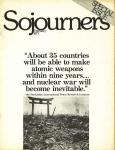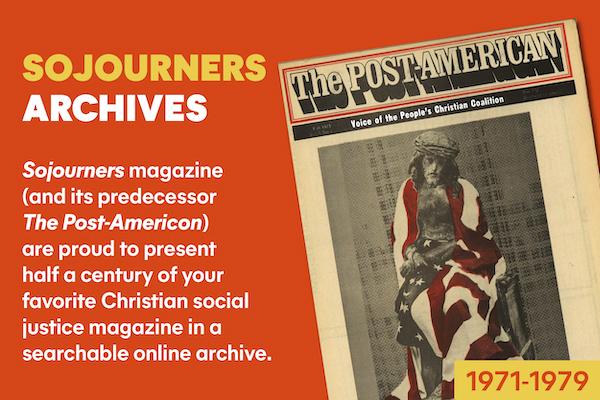In August of 1945, an American B-29 bomber, the Enola Gay, dropped the first atom bomb on the Japanese city of Hiroshima. That day marked a great leap forward in the science of military annihilation. Until then, the most destructive weapon which could be dropped from the air was the block buster, a bomb equivalent to about ten tons of dynamite. The atom bomb initiated a whole new principle with the “fission,” or splitting, of a heavy atom, such as uranium or man-made plutonium. The new bomb had a destructive capacity equivalent to from 1300 to 2000 blockbusters, and it completely destroyed a city of 300,000 people.
By 1976, according to Ruth Legar Sivard, former chief economist of the Arms Control and Disarmament Agency, the United States possessed “a nuclear stockpile of 8,000 megatons” (i.e. 8,000 million tons of dynamite equivalent). That is equal to 615,385 bombs like the atom bomb dropped on Hiroshima, which immediately killed 78,000 people, injured 84,000 and demolished 62,000 buildings. “Using the Hiroshima analogy,” says Sivard, “the nuclear stockpile of the United States alone translates into a potential kill-power 12 times the present world population.”
The rest of the world, mainly the Soviets, possess another 8,000 megatons of nuclear warheads, and the United States continues to produce nuclear weapons at the rate of three new ones each day. Sidney Lens, who has written extensively on the nuclear threat, warns us that “humanity is at the threshold of still another ‘new era’ in which the ‘peaceful’ use of the atom for electrical energy will make it possible within the next few years for dozens of nations--not to mention terrorist gangs--to fabricate their own atom bombs. What was once the monopoly of one country, then of two, three, and six, threatens to become the property of almost every tin-horn dictator and opportunist on the globe.”
I have grown up as part of a generation which has never known what life is like without the bomb. From my earliest recollections I remember being told that our national security rested upon a delicate “balance of terror” that depended upon our staying ahead of the Russians in our ability to kill the most people through ever improving and expanding weapon systems. For most of us, living with the bomb and its balance of terror has become normal.
It has been so frequently repeated that humanity has finally acquired the means of its own total self-destruction, that the fact no longer shocks anyone. Everybody has heard it, but no one seems to believe it, or at least to take it too seriously. Politicians and national leaders readily acknowledge the impending threat of global suicide in the escalating nuclear arms race and then proceed to act as if that fact were irrelevant. It is almost as if we believe on one level that the nuclear weapons capable of destroying us are there, but on a deeper level we seem to not really believe they exist.
Perhaps it is because the nuclear danger has come upon us gradually, over a period of thirty years, that we have been able to lull ourselves into a false sense of security, passively living with the illusion that such weapons of ultimate destruction will never be used, or will never affect our lives in any real way. We fail to understand that the bomb has already deeply affected our lives. For in accepting its presence and its endless proliferation, we have accepted a kind of spiritual death for ourselves in which insanity has become normalcy.
A “prophetic” clock face in the editorial offices of the Bulletin of Atomic Scientists has for the past 28 years warned of the threat of a nuclear doomsday. The hour hand has always been near 12 o’clock midnight. The minute hand has moved with the events of international politics and the editor’s evaluation of the degree of danger the world faces year by year. Today the editors have moved the minute hand on their clock forward to nine minutes before midnight, believing the threat of nuclear war to be greater than ever before.
Recently at the much discussed Cambridge Forum, nuclear experts from the Harvard-MIT Arms Control Seminar concluded that nuclear war by 1999 is not longer just possible, but is now probable. They make the following key points: (1) Nuclear war in some form is likely before the end of the century. (2) It will probably occur as the direct result of proliferation of nuclear power and weaponry. The more people who have such weapons, the more probable their use. (3) Existing political systems and the policies they generate fail to provide curbs on or alternatives to the proliferation of nuclear weapons. Nations continue to increase their armories in the name of self-protection. (4) To survive in such a world, nations may have to surrender much of sovereignty. Nuclear war is a more likely prospect.
This special issue of Sojourners surveys why nuclear experts across the political spectrum now describe nuclear war before the end of this century as a probability. Many Americans are still not aware that the United States government has made a dramatic change in its policy on nuclear war in the last two years. The former policy of mutually assured destruction (appropriately abbreviated MAD) has now been replaced by plans for “limited nuclear war”, perhaps in Europe, the Middle East, Korea, or in revolutionary situations in the Third World--by plans for first strike nuclear capability, and by the creation of a new “counter-force” nuclear policy. The United States has reversed its policy that it would not be the first to use the nuclear bomb. “Under no circumstances should we disavow the first use of nuclear weapons,” said Gerald Ford, in July, 1975. The U.S. has undertaken this new policy of expressed willingness to initiate the first use of nuclear weapons in a military conflict in order to “maximize our flexibility.” This new and more aggressive nuclear policy by the United States includes the development of huge, elaborate new weapon systems on land, in the sea, and in the air. The new arms race is now combined with an uncontrollable proliferation. Pledges to limit nuclear arms have been made by every President since Truman, and were again promised in Jimmy Carter’s inaugural address. Under each President we have seen in increase in nuclear weaponry, not a freeze or a decrease. The cycle of spiraling armaments was created and is fueled by American goals of winning, of superiority, of being number one in the world, of protecting a global economic empire. The most powerful institutions and bureaucracies in this country, business corporations, the Pentagon, intelligence agencies, lobby groups, congressional committees, the labor movement, think-tanks, etc., have a vested interest in perpetuating and escalating the arms race. They continually work to create a climate of fear in this country that the Soviets or some other communist power will overrun America unless we continue to increase our military superiority through ever-growing arms expenditures for new weapons systems.
The churches are deeply complicit in all of this. The churches are as silent, as passive, as accepting of the nuclear madness as they were in 1959, when Karl Barth made his statement against the paralysis of the church in the face of global nuclear destruction. As the Christian community was complicit in the holocaust which occurred against the Jews in Nazi Germany, the church is now complicit in the holocaust which will occur in a nuclear war.
As in other things evangelical, conformity and complicity to U.S. nuclear insanity is more bizarre and pronounced than in other sectors of the church. Evangelical leaders have been deafeningly silent on the nuclear question. A leading evangelical magazine like Eternity prints the idiocy of fundamentalist soothsayer Hal Lindsey:
I would also feel that if we had a president who really believed prophecy, that he would keep American militarily very strong and he would not let, for instance, the Russians have the initiative, that he would back them down. Even if this weren’t prophetic, I believe biblically that’s the posture to have. We would have strong military posture and demonstrate the obvious will to use it if necessary.
The Pentagon itself is honeycombed with prayer groups, giving Christians in the Pentagon an opportunity to pray together in the midst of calculating acceptable kill ratios in nuclear first strikes against enemy populations. Daily religious services are held at the Pentagon for those of every faith and the “Pentagon pulpit” brings famous preachers to the Pentagon nine times a year for religious and national holidays. The Pentagon chaplain told Sojourners that all speakers are coordinated through his office to “avoid any embarrassing situations.” This Pentagon piety is perhaps the most bizarre contemporary example of how the worship of God has been replaced with the worship of the state in all its violent power.
Resistance to the military aggression of nation-states is always a Christian responsibility. However, the fact that world rulers are now marching us all into nuclear oblivion makes Christian resistance to that insanity an imperative. Unless and until possession and use of nuclear weapons is publicly and totally repudiated by the United States and the other nuclear powers, every Christian community and congregation must struggle to find meaningful, consistent ways of acting against present nuclear policies. It is often difficult to know how we should respond, but it is no longer possible for us not to respond.
Jim Wallis was editor-in-chief of Sojourners when this article appeared.

Got something to say about what you're reading? We value your feedback!
